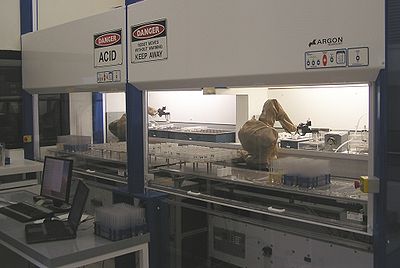
Laboratory robotics
Encyclopedia
Laboratory robotics is the act of using robot
s in biology
or chemistry
labs. For example, pharmaceutical companies employ robots to move biological or chemical samples around to synthesize novel chemical entities or to test pharmaceutical value of existing chemical matter.
Laboratory processes are suited for robotic automation as the processes are composed of repetitive movements (e.g. pick/place, liquid & solid additions, heating/cooling, mixing, shaking, testing).

, to store such samples.
The microtiter plate standard was formalized by the Society for Biomolecular Screening in 1996. It typically has 96, 384 or even 1536 sample wells arranged in a 2:3 rectangular matrix. The standard governs well dimensions (e.g. diameter, spacing and depth) as well as plate properties (e.g. dimensions and rigidity).
A number of companies have developed robots to specifically handle SBS microplates. Such robots may be liquid handlers which aspirates or dispenses liquid samples from and to these plates, or "plate movers" which transport them between instruments.
Instrument companies have designed plate reader
s which can carry out detect specific biological, chemical or physical events in samples stored in these plates. These readers typically use optical and/or computer vision
techniques to evaluate the contents of the microtiter plate wells.
Robot
A robot is a mechanical or virtual intelligent agent that can perform tasks automatically or with guidance, typically by remote control. In practice a robot is usually an electro-mechanical machine that is guided by computer and electronic programming. Robots can be autonomous, semi-autonomous or...
s in biology
Biology
Biology is a natural science concerned with the study of life and living organisms, including their structure, function, growth, origin, evolution, distribution, and taxonomy. Biology is a vast subject containing many subdivisions, topics, and disciplines...
or chemistry
Chemistry
Chemistry is the science of matter, especially its chemical reactions, but also its composition, structure and properties. Chemistry is concerned with atoms and their interactions with other atoms, and particularly with the properties of chemical bonds....
labs. For example, pharmaceutical companies employ robots to move biological or chemical samples around to synthesize novel chemical entities or to test pharmaceutical value of existing chemical matter.
Laboratory processes are suited for robotic automation as the processes are composed of repetitive movements (e.g. pick/place, liquid & solid additions, heating/cooling, mixing, shaking, testing).

Biological Laboratory Robotics
Biological and chemical samples, in either liquid or solid state, are stored in vials, plates or tubes. Often, they need to be frozen and/or sealed to avoid contamination or to retain their biological and/or chemical properties. Specifically, the life science industry has standardized on a plate format, known as the microtiter plateMicrotiter plate
A Microtiter plate or microplate or microwell plate, is a flat plate with multiple "wells" used as small test tubes. The microplate has become a standard tool in analytical research and clinical diagnostic testing laboratories...
, to store such samples.
The microtiter plate standard was formalized by the Society for Biomolecular Screening in 1996. It typically has 96, 384 or even 1536 sample wells arranged in a 2:3 rectangular matrix. The standard governs well dimensions (e.g. diameter, spacing and depth) as well as plate properties (e.g. dimensions and rigidity).
A number of companies have developed robots to specifically handle SBS microplates. Such robots may be liquid handlers which aspirates or dispenses liquid samples from and to these plates, or "plate movers" which transport them between instruments.
Instrument companies have designed plate reader
Plate reader
Microplate Readers are laboratory instruments designed to detect biological, chemical or physical events of samples in microtiter plates. They are widely used in research, drug discovery, bioassay validation, quality control and manufacturing processes in the pharmaceutical and biotechnological...
s which can carry out detect specific biological, chemical or physical events in samples stored in these plates. These readers typically use optical and/or computer vision
Computer vision
Computer vision is a field that includes methods for acquiring, processing, analysing, and understanding images and, in general, high-dimensional data from the real world in order to produce numerical or symbolic information, e.g., in the forms of decisions...
techniques to evaluate the contents of the microtiter plate wells.
Advantages
- Faster processing (Note automation is not always faster than a human operator)
- Increased repeatability
- Increased productivity
- Improved efficiency
- High reproducibility
- Establish safer working environments
- Reduction in materials wastage due to optimized process variables
- Ability to perform work continuously unaffected by human constraints
- Able to perform work in and around harsh environments.
- Withdraws staff from boring, repetitive tasks
Disadvantages
- Single / one off sample assessments are expensive
- Many laboratory techniques have not yet been developed for robotic automation
- Difficult to automate in instances where visual analysis / recognition / comparison is required
- Analysis is limited by available sensory inputs
- Increases job shortages

